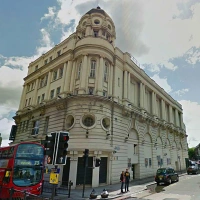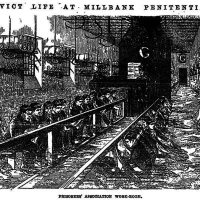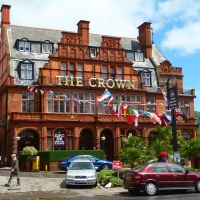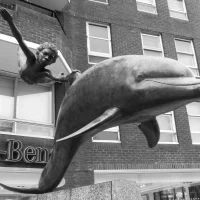“In the clearing stands a boxer
And a fighter by his trade
And he carries the reminders
Of every glove that laid him down
Or cut him till he cried out
In his anger and his shame
‘I am leaving, I am leaving’
But the fighter still remains…”
(From ‘The Boxer’, Simon and Garfunkel, 1968)
*
From the ancient Roman amphitheatre to the recent 2012 Olympic village, London has been home to an impressive array of sporting venues over the centuries.
One such arena, now sadly long vanished, was ‘The Ring‘; a boxing stadium which once stood on Blackfriars Road in Southwark.
Although established as a boxing venue in 1910, the actual building dated all the way back to 1783; originally designed as a chapel by the Reverend Rowland Hill- who reportedly opted for the unusual, circular design so that there would be no corners in which the devil could hide….
Decades later, the man responsible for overseeing the chapel’s conversion from prayer to pugilism was Dick Burge, a former English Middleweight champion who hailed from Cheltenham in Gloucestershire.
Dick retired from the noble art in 1900 but, whilst living on Wiltshire Road in Brixton, he soon found himself encountering financial difficulties.
Foolishly, he sought to remedy his woes by participating in a huge Liverpool-based bank fraud which involved a risky mixture of cheque forgery and high-stakes racecourse gambling.
The scam was soon rumbled and Dick was arrested in October 1901; just one month after he’d married his wife Bella at Brixton registry office.
Tried and found guilty for his part in the crime, the former boxer was sentenced to ten years hard labour.
*
Eight years into Dick’s sentence, a violent prison riot erupted.
During the chaos, Dick- who had already proved himself to be a well behaved, model prisoner- courageously risked his neck in order to save a guard whose life was under threat from the rampaging mob.
Thanks to this commendable redemption, Dick was released from prison two years early and promptly vowed to return to a more law-abiding life.
Supported by his wife Bella, who had stuck by her man throughout the prison term, Dick succeeded in renting out the old, circular chapel on Blackfriars Road.

1860s map depicting the chapel which would later become The Ring boxing venue. Charlotte Street is now known as Union Street.
By this point, Rowland Hill’s old place of worship had fallen into use as a warehouse and was in a very sorry state.
Undeterred by the task ahead, Dick and Bella enlisted the help of local homeless people to clean out the building and transform it into a state fit for presenting boxing to the public.
The Ring opened on the 14th May 1910, quickly attracting keen crowds- and with the Blackfriars arena staging events four to five times a week, there was certainly plenty for fight fans to indulge in.
Not forgetting the help they’d received from London’s homeless, Dick and Bella set up a soup kitchen which they ran from the building during the quieter daytime hours.
*
Just four years after The Ring opened, The Great War erupted and Dick, never one to shy away from a fight, enlisted with the First Surrey Rifles.
Tragically, the former boxer contracted pneumonia in 1918 and died a few months short of the war’s end.
By this point, he had become a very popular character and some 2,000 mourners attended his funeral at St Marylebone Church. Following the ceremony, Dick’s body was taken to Golders Green for cremation.
The death of Dick Burge however didn’t spell the end of the boxing venue.
On his death bed, Dick had asked his beloved Bella to ensure that she kept their business going. Not wishing to let her husband down, and having practically run the venue since Dick’s enlistment in 1915, Bella promised her husband that she would do so; a vow which essentially resulted in her becoming the world’s first female boxing promoter.
Bella was a tough cookie; a New Yorker by birth who, aged four, had come to London with her mother following the death of her father.
Like her late husband, Bella knew how to put on a good show- she’d worked on the stage and had also been the dresser to one of music hall’s greatest performers; Marie Lloyd; a star with whom Bella became close friends.
When it came to running the Blackfriars boxing arena, Bella was purely hands on, involving herself in every aspect of the venue’s smooth running- right down to personally booting out drunken troublemakers.
Much loved by the local community, the pioneering promoter soon earned an affectionate nickname; ‘Bella of Blackfriars’.
So successful was The Ring under Bella’s leadership that, in 1928, the Prince of Wales- who was a keen fan of the noble art- decided to pop by and enjoy an evening’s boxing at the Ring; the main fight that night being between two highly regarded fighters; Manchester’s Len Johnson and Birmingham’s Jack Hood.

Jack Hood (left) and Len Johnson (right) who boxed at The Ring in the presence of the Prince of Wales.
During his visit, the Prince was greeted by loud chants of “for he’s a jolly good fellow!” which was rather ironic considering he would later go on to become King Edward VIII; the monarch whose 1936 abdication threw the monarchy into crisis…
In 1932, The Ring added more strings to its bow when it added wrestling to the bill…. and the odd Shakespeare play, performed by the local Bankside Players drama group.
By by the late 1930s however and with the clouds of WWII looming, The Ring began to experience fiscal problems which soon became so tough, Bella was forced to pawn her jewellery and other valuables in order to pay the venue’s staff.
Sadly, her stoic attempts would prove to be in vain.
At the height of the Blitz, one night in October 1940, The Ring suffered a direct hit.
The 18th century building, which Bella had steered to greatness after a promise to her dying husband years before, was wiped out in a flash.

Smashed trams on Blackfriars Road, a few yards away from the bombed Ring (image: Nickel in the Machine)
To this day, substantial damage from the raid which blasted the popular boxing venue, is still clearly visible beneath the railway bridge spanning Blackfriars Road.
*
Years later in 1958, Bella Burge was invited onto an early episode of This is Your Life and, in 1961, a book about her entitled ‘Bella of Blackfriars’ was published and serialized in newspapers (the cover of the book can be viewed earlier in this article).
The formidable lady died in 1962, aged 85.
*
The Ring bombsite remained in tatters until the 1960s when a modern office block named ‘Orbit House’ was constructed over the ruins. Orbit House became home to the India Office’s library and archive (now housed in the British Library).
By 1998 this block had also plunged into ruin and, in the first decade of the 21st century, Orbit House was demolished and replaced by an ultra-modern structure called ‘The Palestra’.
Quite fittingly, Palestra is an Ancient Greek term denoting a public arena for wrestling.
The futuristic office complex is now the HQ for Transport for London… something which I’m sure commuters will appreciate considering how much of a fight it can be contending with tubes and buses during the height of the rush hour!
As the base for Transport for London, the Palestra is also the venue where those studying The Knowledge of London (the intense training course you must pass in order to become a London cabbie) attend their ‘appearances’; verbal examinations which are a true wrestle for the mind!
To find out more about my own experience of this process, please click here.
As well as the Palestra’s referential name, a few subtle reminders of Dick and Bella’s much beloved arena can be found nearby.
About half a mile away, in a rather forlorn, windswept section of the Southbank complex (just off of Belvedere Road, near the Purcell Room), a simple mosaic of Bella Burge can be seen embedded into the pavement.
Another mosaic in the set depicts Ernie Izzard; a boxer who lived in Herne Hill and cut his teeth at the Blackfriars ring. Other local heros- including Daley Thompson and Kevin Spacey- can also be glimpsed on this understated walk of fame.
Closer to the Palestra itself, you’ll find The Ring boxing gym on Ewer Street and, right across the road from where the legendary arena once stood, there’s The Ring pub; a boozer which boasts an array of boxing memorabilia… the perfect place to raise a toast to one of London’s most fascinating, lost sports venues.
To see The Ring in action, please click the short clip below, which includes footage of a 1930 bout between Charles Desmet and Jim Shippen.





























Really enjoyed that !!
Musher
Cheers, Musher!
My late Uncle fought theire a good few times, (Dave Finn).
A terrific post. The Ring PH was mentioned in a film I saw recently with John Mills and Stewart Granger (waterloo road 1942). Just about to head out on some runs now over to wimbledon. . I’ll try and find the Bella mosaic on way back home to North London later.
Thanks for that; I never knew the pub was mentioned in that film. Speaking of films, Alfred Hitchcock made an early, silent film in 1926 called ‘The Ring’. Apparently he was a regular spectator at the venue and it inspired his work.
Good luck finding the mosaic! It’s at ground level, near the Purcell Room and just around the corner from a skate-park.
Thanks, I’ve seen the Lodger which was around the same time (1927) but not the ring, I’ll try and track it down.
Talking of Hitch’ I recently recoreded on sky The Man who knew too much (1956) which I hadn’t seen for years. You can clearly see James Stewart get out of a taxi on Plender St, with Royal College Street in the background.
Hello,
Great post.
The film you mention, Waterloo road. Stewart Grangers character is a former fighter that was meant to have been a regular at the ring.
My grandad talks about going to watch the fights there when he was young and the huge crowds that packed the place out.
Great comment, Rob. Many thanks for the info 🙂
Another great blog, i work in Palestra, now know why the small block of flats opposite is called Rowland Hill House
Great comment, Richard- I completely forgot to mention Rowland Hill House! Many thanks 🙂
I only discovered two days ago that Dick and Bella are my relatives 🙂 So proud to know that all this this is part of my family history. Daniel
Wow! Very nice to know a relative of theirs found my website! 🙂
I have often wondered by the flats opposite The Palestra are named Roland Hill House, great post
Many thanks, David.
my great grandad boxed out of there arthur Lloyd
He was also my Husbands gt grandad. (Terry Pateman). how are you related?
That was a great post – I love stuff like this ! London has some great old venues. Found some more info and pics over at http://www.nickelinthemachine.com/2009/06/blackfriars-road-the-ring-and-the-death-of-al-bowlly/
Thank you, Dale 🙂
Hi
Jim shippen in the above video was my grandfather,
Does anyone have any more footage or any photos of
His boxing career?
Thanks in advance
Ray
Ray.taylor@networkrail.co.uk
Hi Ray,
You could perhaps try the London Ex-Boxers Association? Best of luck.
We lived in Union Street and my Grandad used to box in the Ring for prize money.
His name was Charlie Bewsey.
Thanks for that, Fred. Do you know anymore about your Granddad’s boxing days?
No , not really . He was a man of few words, but he did have a couple of cauliflower ears!
That’s a shame, would have been great to learn a little more about him. Sounds like he was a pretty tough bloke!
Has anyone ever heard of Arthur loyd he fought kid berg twice at that ring & had over a hundred &eighty fights
My mother said her dad stayed upstairs in there for a few years and met my nan at the elephant it must have been in the late 50s early 60s his name was william, grandad bill
Nice personal history 🙂
Great site my great granddad boxed there many times . have dedicated a website to him
http://www.nigelharding.wixcom/harryduncanboxer.
Cheers!
Thanks Nigel, love your site- especially the old photos 🙂
Cheers and thanks again.
[…] the devil could hide. By 1910, it was being used as a warehouse when boxer Dick Burge decided to turn it into a boxing venue. The Ring was a success but was hit by a bomb on 25th October 1940 and then again in March 1941. […]
My GRANDAD boxed at the ring in Blackfriars from 1925, HE bought my mum’s shawl with his winnings. I am now the proud owner of all his press cuttings. Ernie Simmonds [THE BATTLING DUSTMAN] 100 fights never got knocked out. bless him
Wow… he sounds like an incredibly tough fellow!
Very tough man indeed my great grandfather RIP
My grandfather regularly boxed at The Ring. His name was Albert Lawrence but because he always wore green shorts he was nicknamed “Pat”. He went on to establish the Bermondsey bookmakers “Pat Lawrence Ltd”. He also organized numerous charity variety shows for the poor of Bermondsey. I have a cutting from the South London Press of his funeral in 1936 showing thousands of people standing bare-headed along the Old Kent Road as his funeral cortège passed by on its way to Nunhead Cemetery. A hard life had taken its toll. He was just 51. My father often spoke of The Blackfriars Ring.
Wow…. incredible family history, John.
[…] during the Blitz in 1941. The Arena had a fascinating history and you can find out more from this excellent article about it. Now on the site is the modern office building The Palestra. Some of the trinkets on the wall […]
I am researching for a book and website on Bristol boxing history and am particularly interested in a Bristol boxer called George Rose who had over 200 fights between 1926 and 1937. He fought at The Ring Blackfriars many times over his career and was hoping someone may have some clippings, photos, pictures or posters of him or his name mentioned on old boxing flyers. My email address is leewoodward1974@yahoo.co.uk.
Bert Assirati (Islington) was the most well known heavyweight wrestler ever to appear at The Ring, Blackfriars he was the British champion, and beat all the leading heavyweight wrestlers from Britain, Europe, and America. He also used to train at The Ring, Gym.
He appeared there from 1932 to 1939, and had his last match their in August 1939. His most famous match there was against the 6 feet 5 inch 19 stone Russian giant Kola Kwariani in 1934, he twice threw him out of the ring into the ringside spectators, where the Russian was injured, and failed to make it back into the ring. The referee declared Assirati the winner, but Assirati refused to accept the verdict, so they wrestled again the following month, and again Assirati won the match.
I purchase for cash all memorabilia about Bert Assirati, including photographs, programmes, posters, etc……
I have two web-sites remembering the great days of “All-In” wrestling at http://www.allinwrestling.co.uk and http://www.bertassirati.com
Best wishes Mike Hallinan Edgware London
MikeHallinan2001@aol.com
[…] View from the Mirror. “From Prayer to Palestra: The Ring at Blackfriars.” View from the Mirror: A Cabbie’s London. Last modified 4th February 2013, accessed 20th June 2016. Available at https://blackcablondon.net/2013/02/04/from-prayer-to-palestra-the-ring-at-blackfriars/ […]
[…] Click to read a blog post on the esteemed history of The Ring as the home of boxing. The venue also doubled up as a soup kitchen during the day as well as a music hall. […]
My Grandad, Lew Hart fought at The Ring. He boxed from 1913-1922. His oldest daughter Anne married my dad in WWII and moved to America. The first time I met her parents was in 1956 when they came to visit. I will never forget him making a fist with his thumbs sticking out and tell me and my twin sister to each grab one and then lift us up over his head. We were seven years old.
Many thanks for sharing, John.
I am writing a play about Eugene Jacque Bullard, the first black man from Georgia, USA, to pilot a fighter plane for the French Air Service during WW1. Before the war he was a boxer along with the Dixie Kid and fought several matches at the Ring Blackfrair in the 1913 time period.
Sounds like an incredible man, Mark. Best of luck with the play.
My grandfather fought at the Blackfriars ring, I believe it was between the two wars, I was told he did it for the prize money. He was a dock worker. He fought under the name Billy Boyton, any information would be appreciated. His real name was William Grimsey, but he was known as Bill or Billy.
Hi John, your grandfather sounds like he was a very tough bloke! Unfortunately I do not have access to such information though; perhaps you could try one of the boxing magazines, I think they have pretty big archives? Best of luck.
My grandfather also boxed at the ring between the wars his name was frank Dowle , I think he was a bantamweight . He lived locally with his wife Ann and only son Bernard. He was a barber in his day job and as far as I know was a talented boxer with a good local following. If anyone has any information about him I would be pleased to hear from you . Kind regards Allan Dowle
My wife’s grandfather Fred ‘Freddie ‘ Anderson fought at the Ring many times up to 1917,when he found out his wife was pregnant and promised to hang up his gloves.He was a local boy living in The Cut .His most memorable fight was against European Champion Eugene Crikey in Paris [ a non title fight ] .He lost on points. Died early, too many fights,too often.
Thanks for sharing, Chris. They were tough folk for sure in those days.
My grandfather, Ted Rich, was reported to be “whip of the ring, Blackfriars” for 10 years. What does this mean, please?
[…] grave was purchased by Marie’s close friend and fellow artist and later the owner of The Ring, Bella Burge. Her funeral took place on 12 October. A dozen cars were needed to carry just the […]
in 1977 as a 16 year old I knew a old boy at a pub I worked at nr Watford I was a amateur boxer and the old boy was about 80.we talked boxing a lot and he told me his dad took him to the ring in 1911 where he says he witnessed world heavyweight champ jack Johnson fighting a exhibition bout.i cant find any anything on jacks appearance at the ring although he was in London that year on route to Europe in exile.
[…] interesting fact about the Ring venue is that it was run by Bella Burge- aka ‘Bella of Blackfriars’- who is believed to have […]
My grandad fought bare knuckle at the Ring to earn a bit to support the family, he was known I believe as Battleing Sid Lowe I am 75. He was a really lovely man, and lived in wadhurst Road Battersea. Any information on him would be good, he worked at Battersea Power Station.